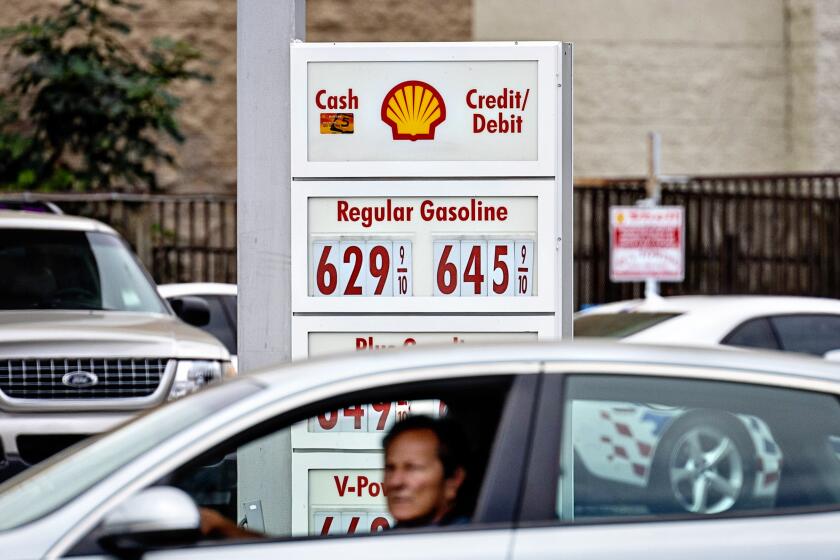Gas prices are on the rise. Here’s how to find the cheapest options

- Share via
Experiencing sticker shock at the pump? Gas prices throughout California are soaring in comparison with the national average.
California’s prices averaged $5.37 a gallon as of Tuesday, versus the national average of $3.60.
In the Los Angeles-Long Beach metro area, a gallon of regular self-serve gasoline costs a few pennies less on average than in the rest of the state: $5.34. Still, that’s up 18 cents from last week and about 40 cents from last month, according to the American Automobile Assn.
Gas prices are going up across the country, AAA’s survey shows, but not nearly as fast as in California. The average price of regular gas in the Golden State is up 25 cents from last week and almost 50 cents from a month ago, AAA says.
A tight oil market, due in part to attacks on commercial ships in the Red Sea and production cuts in other countries, will keep fuel prices above average, according to U.S. Energy Information Administration projections.
The federal agency’s global forecast of oil balances and their effect on crude prices in the U.S. remains uncertain. Although events such as the attacks on ships in the Red Sea haven’t harmed oil production yet, the EIA said, production could “still be disrupted or some oil production in the Middle East could be shut in, which would likely cause oil prices to increase.”
Higher crude oil prices and increased demand for fuel from spring break road trips have pumped up gas prices in California.
Another factor is the war between Russia and Ukraine. In recent months, Russia’s refineries and oil terminals have become priority targets of Ukrainian drone attacks.
“Uncertainty [about] the impact of Ukraine’s targeting of Russia’s oil infrastructure likely spiked oil prices recently,” AAA spokesperson Andrew Gross said in a March statement. “But those concerns have abated somewhat for now, and gas prices are settling into a pattern similar to last year when the usual seasonal increase was slow and steady.”
Historically, gasoline prices tend to gradually rise in the spring and peak in late summer, when people drive more frequently, according to the EIA.
California’s prices also are affected by the shift to a different fuel blend in warmer weather. Environmental regulators require that gasoline sold in the summer be less susceptible to evaporation. This requirement has refiners replacing cheaper but more evaporative components in gas with those that have the opposite characteristics, the federal agency said.
Other parts of Southern California have seen eye-popping price increases. In the San Diego metro area, the average price for a gallon is $5.31, up 16 cents from last week, and in Riverside, it’s $5.25, up 19 cents.
But you don’t have to pay the highest possible price to fill your tank.
How to find cheaper gas
There are several apps and websites that can help you find lower prices near your traveling route.
- The Auto Club app for AAA members shows the closest gas stations that are charging the lowest amount, anywhere in the United States.
- In its app and on its website, Gasbuddy displays real-time pump prices near you.
- The Gas Guru app can search for gas stations by price, fuel grade and distance, as well as show prices in your area.
- Mapquest, Google Maps and Waze have a feature that enables you to see gas prices on the route of your trip.
More to Read
Sign up for Essential California
The most important California stories and recommendations in your inbox every morning.
You may occasionally receive promotional content from the Los Angeles Times.















